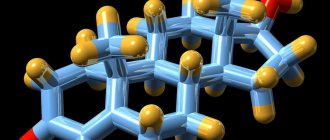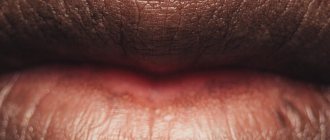Natalya Reznik, Candidate of Biological Sciences
“Chemistry and Life” No. 9, 2016
A woman takes care of the home: she extinguishes emerging conflicts and radiates goodwill and peace. A man protects his home, not allowing hostile people or just strangers into the family circle. These traditional patterns of behavior have lasted for several millennia because they rely on physiological differences between the sexes. And an important role in these differences is played by the hormone oxytocin, which enhances female goodwill and male aggressiveness.
Oxytocin - the hug hormone
The cuddle hormone or oxytocin has certain physiological functions. Its main task is to promote procreation. The production of the hormone is observed not only in humans, but also in animals. The substance is released into the blood during orgasm and also stimulates muscle contractions, helping the male sex hormones reach the egg. During labor, oxytocin triggers contractions. Its role in the life of a man and a woman is very important.
Oxytocin is a hormone that also affects a person’s physical condition. Studies have shown that its presence in the body has a positive effect on the functioning of all organs and systems.
Oxytocin regulates the production of the male sex hormone testosterone. It reduces the synthesis of cortisol and adrenocorticotropic hormone. The main task of a person is to monitor the level of oxytocin in the body. Excess of the hormone can lead to poor functioning of the adrenal glands and provoke a general loss of strength.
Oxytocin is:
- normal functioning of the nervous system;
- restraining emotions and eliminating negative perceptions;
- normalization of libido;
- normalization of general condition.
According to studies, the hormone reduces symptoms of pain, facilitates menstruation and relieves a person from a depressive state. It has a positive effect on the functioning of organs and systems.
Microbes, the hormone oxytocin and healthy longevity
Beneficial microbes stimulate hypothalamic hormones and immune tolerance for healthy longevity
Susan
E Erdman
Microbes, Oxytocin, and Healthful Longevity
Journal of Probiotics & Health -
2014, 2:117
annotation
The microbiome has been shown to play an important role in human health. Recent studies in mice show that gut microbes stimulate the host neuropeptide oxytocin
and immune physiology in a mind-body paradigm with various effects, improving systemic wound healing capacity. Oxytocin is best known for its role in reproduction and immunity, but more recently it has been implicated in obesity, human bonding and trust. Microbial reprogramming of host oxytocin may provide far-reaching physical, mental and social health benefits for healthy longevity.
Introduction
The potential of the microbiome to optimize mammalian health is only now being recognized [1–4]. In a series of recent manuscripts, Poutahidis et al. It has been shown that model intestinal microorganisms can stimulate host hormones and immunity to improve wound healing capacity [5], inhibit obesity [6], and support reproductive functions [7]. Although the microbial pathway of stimulating oxytocin production is unprecedented, alliances between gut microbes and CD4+ regulatory T cells have been shown to influence various inflammatory processes, including body fat deposition [8]. Indeed, consumption of purified probiotic microbes reduces the risk of obesity in humans [9]. Substantial indirect support also exists from scientific and epidemiological studies linking microbes to systemic health [1–4, 10–22]. Despite the enormous potential for improving quality of life, exogenous administration of pluripotent hormones such as oxytocin has proven difficult. Beneficial microbes can overcome this and, as a result, have far-reaching potential benefits for a person's physical, mental and social health.
Probiotic Microbes Stimulate Positive Immune Tolerance
It is widely recognized that the alliance between gut microbes and CD4+ regulatory T (Treg) lymphocytes dramatically influences whole-body health outcomes [8,11,23–26]. Immune tolerance prevents an overreaction to self or environmental factors that would otherwise cause an adverse inflammatory response. Tolerance is mediated by a subset of CD4+ lymphocytes, namely Treg cells, which serve to attenuate detrimental inflammatory responses. Thus, the increased capacity for immune tolerance helps the body recover from injury, at least in part by rapidly eliminating damaging chronic inflammation in the form of neutrophils and mast cells [6,27]. Recently, it was found that the addition of the oral purified probiotic model organism Lactobacillus
reuteri
(LR) resulted in complete wound reepithelialization in half the time required for untreated controls, in an oxytocin-dependent manner, leaving only minimal scar tissue afterwards [5]. Similarly, LR feeding induced immune tolerance and reduced the burden of breast cancer in mouse models [28]. The parallels between wound healing and cancer are logical, since “cancer is a wound that will not heal” [29]. The fact that oxytocin enhances the expression of interferon gamma (IFN-γ) in a tightly controlled immune system may help explain its beneficial role in cancer protection [5,30–32].
Substantial mechanistic insight was gained from the observation that cellular transfer of highly purified immune tolerance cells, CD4+CD25+Foxp3+Treg cells, was sufficient to recapitulate microbe-induced enhancement of wound healing [5]. Transplanted Treg cells have been found to significantly reduce age-related weight gain [6] and cancer burden [28]. In mouse models, the effectiveness of microbe-induced Tregs depended on the presence of the neuropeptide hormone oxytocin [5]. This suggests that edible microbes could be used prophylactically or therapeutically to induce dramatic hormonal and immune changes in animal hosts. It is tempting to extrapolate these data to mice to capture the broader microbial ecology. However, many recent discoveries of microbe-host interactions have yet to be proven in humans.
Microbes upregulate the neuropeptide hormone oxytocin with improved wound healing ability
Oxytocin is a neuropeptide hormone that plays a fundamental role in social bonding and reproduction in mammals. In addition to key physiological roles in childbirth and nursing, it is now widely recognized in metabolism, the immune system, and central nervous system (CNS) functions such as social memory and attachment, sexual behavior, aggression, human bonding and trust, learning, creativity, anxiety, eating behavior and pain cognition in both men and women [17–22,30,31,33]. Recently, oxytocin was found to be integral to microbe-induced immune benefits in wound healing via the vagus nerve-mediated pathway [5]. The ability to effectively heal wounds ranges from recovery from minor injuries to diabetes and some types of cancer [2,3,10–12], which together contribute to healthier aging.
The recent discovery that gut microbes can stimulate oxytocin to improve wound healing and healthy longevity [5] is based on a solid foundation of science. Oxytocin has recently been shown to reduce debilitating conditions and sarcopenia in aging animals, resulting in stronger skeletal muscle [34]. Oxytocin has also recently gained traction as a key molecule not only in overall immune system balance and health, but also in feelings of social well-being, love, spirituality and satisfying life experiences. Such social connections are known to improve wound healing processes in humans [35].
Finally, oxytocin also increases generosity and empathy [17–22], promoting not only longer life but also the experience of a more meaningful life.
Wound healing, oxytocin and the mind-body connection
Human civilization has long postulated psychological well-being and the mind-body connection as the foundation of healthy aging. Freedom from disease throughout life is based on the host's ability to respond effectively to injury, infectious agents, and social stress, with the homeostatic balance of the entire organism resulting in minimal pathology [36–39]. The discovery that beneficial bacteria improve recovery from tissue damage integrates oxytocin and immune tolerance into the mind-body connection (Figure 1) [5]. This consists of the effects by which oxytocin enhances immune tolerance, preventing overreactivity to self or environmental factors that would otherwise cause an adverse inflammatory response. Tolerance is conveyed by a subset of CD4+ lymphocytes, namely T regulatory (Treg) cells, which serve to suppress harmful inflammatory responses. The increased ability of immune tolerance in the presence of oxytocin in mice promotes the healing of their skin wounds, at least in part through rapid clearance of neutrophils and chronic inflammation [5, 27]. Although this oversimplifies a complex process, oxytocin has been shown to activate IFN-γ to induce sustained but highly regulated integral immunity for good health [5,30–32]. The sum of this provides re-epithelialization (wound healing) in half the time required for untreated controls, leaving only minimal scar tissue [6].
This is what mammals are made of: commensal microbes, immune tolerance and oxytocin.
It is well known that the connection between a microbe and a hormone begins before birth. In healthy mammals, microbes stimulate immune tolerance using the sex steroid hormones, oxytocin and interleukin (IL)-10, to support long-term placental pregnancy [40]. At birth, oxytocin simultaneously activates the expression of IFN-γ and CD25, establishing a mechanism of immune recognition of self versus non-self [30–32]. In later life, this same oxytocin metabolism maintains immune and integumentary homeostasis by biasing the immune system toward IL-10 and IFN-γ, and therefore minimizing the deleterious systemic effects of IL-6 and IL-17 that accelerate morbidity and premature death. death [6]. Oxytocin also regulates gamma-aminobutyric acid (GABA) neurotransmitter signaling in the central nervous system [41], providing favorable mood rewards [16] for social and overall satisfaction. Emerging evidence links oxytocin to obesity, fat metabolism [42,43] [6], the musculoskeletal system [34] and the immune system [5,30,31,33], supporting its role as a global regulatory hormone.
Figure 1. Gut microbes stimulate hormonal and immune signaling for healthy longevity. Healthy aging is generally associated with the ability of the host to respond to tissue damage with effective homeostatic balance and minimal pathology. Effective injury recovery and lifelong good health are regulated by hypothalamic hormones (eg, oxytocin) integrated with peripheral endocrine glands (eg, adrenal cortex, thyroid, and gonads) in conjunction with the systemic immune system. Recently, beneficial gut microbes were found to stimulate oxytocin, which regulates the expression of interferon (IFN)-γ and CD25 for immune tolerance in a transplantable manner. Together, this prevents overreactivity to self or environmental factors that otherwise lead to premature death.
These diverse phenotypes caused by probiotic microbes have perinatal effects that can extend across generations. Oxytocin, for example, is inversely associated with postpartum depression and maternal neglect in women [44]. Although oxytocin promotes cooperation within kin groups, it promotes aggression towards competitors [45]. These interrelated roles of oxytocin may influence the process of natural selection to favor the complex social organizations necessary for mutual evolutionary success. Through the action of microbe-induced hormones such as oxytocin, gut bacteria can influence our desires and identity as people.
Using microbes for healthy longevity.
In adulthood, these microorganisms stimulate immune tolerance and the hypothalamic-pituitary axis to improve host fitness and reduce the disorders of aging. Features associated with superior fitness and youth include mucosal hyperactivity and follicular anagenesis [46]. All of this makes good sense from an evolutionary perspective, as commensal microbes have coevolved with mammals, exploiting host immunity and endocrinology for mutual benefit [46,47]. During periods of fertility, the immune and hormonal effects of probiotic organisms dominate interactions with the environment and promote host survival and reproductive success [46]. Increased immune tolerance to probiotics allows prolongation of placental pregnancy [40], while hyperacid mucus suppresses pathogens that otherwise interfere with gastrointestinal health, fertilization and pregnancy. Disruption of this natural symbiotic cycle through obsessive social hygiene practices results in insufficient levels of IL-10 in the mucosa [24,25], promoting immune dysregulation with an increased risk of premature death. Under favorable conditions, these probiotic bacteria are then passed from mother to naïve offspring during vaginal birth and lactation, conferring evolutionary success on both the symbiotic bacteria and their mammalian hosts.
In conclusion, oral microbes may reduce the impairments of aging and impart healthy vitality typical of much younger adults [5,7,46], providing the psychological and physiological foundations of healthy longevity. In preclinical models, microbes have been shown to reduce age-related weight gain [6] and the burden of cancer [28], which contributes to premature aging. Measurable benefits in wound healing capacity are directly reflected in almost every aspect of conventional health and medicine [42,48], while integrating social support networks with improved trauma management for healthy and meaningful living [49]. In practical terms, this connection between the microbe, endocrine and immune systems can reduce hospitalizations, improve healing, reduce the risk of some cancers and promote well-being and active participation throughout life. It is not known for sure whether the results obtained in animal models will apply directly to humans. However, peoples around the world have grown and consumed similar food organisms in fermented beverages and active yogurt drinks for thousands of years, supporting a low-risk population-based approach to long, healthy, and fulfilling lives.
Literature
- Gordon J (2012) Honor thy gut symbionts redux. Science 336: 1251-1253.
- Clemente JC, Ursell LK, Parfrey LW, Knight R (2012) The impact of the gut microbiota on human health: an integrative view. Cell 148:1258–1270.
- Shanahan F (2012) The gut microbiota—a clinical perspective on lessons learned. Nat Rev Gastroenterol Hepatol 9:609–614.
- Young VB (2012) The intestinal microbiota in health and disease. Curr Opin Gastroenterol 28:63–69.
- Poutahidis T, Kearney SM, Levkovich T, Qi P, Varian BJ, et al. (2013) Microbial symbionts accelerate wound healing via the neuropeptide hormone oxytocin. PLoS One 8: e78898.
- Poutahidis T, Kleinewietfeld M, Smillie C, Levkovich T, Perrotta A, et al. (2013) Microbial reprogramming inhibits Western diet-associated obesity. PLoS One 8: e68596.
- Poutahidis T, Springer A, Levkovich T, Qi P, Varian BJ, et al. (2014) Probiotic microbes sustain youthful serum testosterone levels and testicular size in aging mice. PLoS One 9: e84877.
- Belkaid Y, Hand TW (2014) Role of the microbiota in immunity and inflammation. Cell 157:121–141.
- Sanchez M, Darimont C, Drapeau V, Emady-Azar S, Lepage M, et al. (2014) Effect of Lactobacillus rhamnosus CGMCC1.3724 supplementation on weight loss and maintenance in obese men and women. Br J Nutr 111:1507–1519.
- Rao VP, Poutahidis T, Ge Z, Nambiar PR, Boussahmain C, et al. (2006) Innate immune inflammatory response against enteric bacteria Helicobacter hepaticus induces mammary adenocarcinoma in mice. Cancer Res 66:7395–7400.
- Rao VP, Poutahidis T, Fox JG, Erdman SE (2007) Breast cancer: should gastrointestinal bacteria be on our radar screen? Cancer Res 67:847–850.
- Scanlan PD, Shanahan F, Clune Y, Collins JK, O'Sullivan GC, et al. (2008) Culture-independent analysis of the gut microbiota in colorectal cancer and polyposis. Environ Microbiol 10:789–798.
- Cryan JF, Dinan TG (2012) Mind-altering microorganisms: the impact of the gut microbiota on brain and behavior. Nat Rev Neurosci 13:701–712.
- Foster JA, McVey Neufeld KA (2013) Gut-brain axis: how the microbiome influences anxiety and depression. Trends Neurosci 36: 305–312.
- Davari S, Talaei SA, Alaei H, Salami M (2013) Probiotics treatment improves diabetes-induced impairment of synaptic activity and cognitive function: behavioral and electrophysiological proofs for microbiome-gutbrain axis. Neuroscience 240: 287–296.
- Bravo JA, Forsythe P, Chew MV, Escaravage E, Savignac HM, et al. (2011) Ingestion of Lactobacillus strain regulates emotional behavior and central GABA receptor expression in a mouse via the vagus nerve. Proc Natl Acad Sci USA 108:16050–16055.
- Gimpl G, Fahrenholz F (2001) The oxytocin receptor system: structure, function, and regulation. Physiol Rev 81:629–683.
- Wismer Fries AB, Ziegler TE, Kurian JR, Jacoris S, Pollak SD (2005) Early experience in humans is associated with changes in neuropeptides critical for regulating social behavior. Proc Natl Acad Sci USA 102:17237–17240.
- Lim MM, Young LJ (2006) Neuropeptidergic regulation of affiliative behavior and social bonding in animals. Horm Behav 50:506–517.
- Donaldson ZR, Young LJ (2008) Oxytocin, vasopressin, and the neurogenetics of sociality. Science 322:900-904.
- Lee HJ, Macbeth AH, Pagani JH, Young WS 3rd (2009) Oxytocin: the great facilitator of life. Prog Neurobiol 88:127–151.
- Meyer-Lindenberg A, Domes G, Kirsch P, Heinrichs M (2011) Oxytocin and vasopressin in the human brain: social neuropeptides for translational medicine. Nat Rev Neurosci 12:524–538.
- Lee YK, Mukasa R, Hatton RD, Weaver CT (2009) Developmental plasticity of Th17 and Treg cells. Curr Opin Immunol 21:274–280.
- Rook GA (2009) Review series on helminths, immune modulation and the hygiene hypothesis: the broader implications of the hygiene hypothesis. Immunology 126: 3-11.
- Rook GA, Dalgleish A (2011) Infection, immunoregulation, and cancer. Immunol Rev 240:141–159.
- Erdman SE, Rao VP, Olipitz W, Taylor CL, Jackson EA, et al. (2010) Unifying roles for regulatory T cells and inflammation in cancer. Int J Cancer 126:1651–1665.
- Costa RA, Ruiz-de-Souza V, Azevedo GM Jr, Gava E, Kitten GT, et al. (2011) Indirect effects of oral tolerance improve wound healing in skin. Wound Repair Regen 19:487–497.
- Lakritz JR, Poutahidis T, Levkovich T, Varian BJ, Ibrahim YM, et al. (2014) Beneficial bacteria stimulate host immune cells to counteract dietary and genetic predisposition to mammary cancer in mice. Int J Cancer 135:529–540.
- Dvorak HF (1986) Tumors: wounds that do not heal. Similarities between tumor stroma generation and wound healing. N Engl J Med 315:1650–1659.
- Macciò A, Madeddu C, Chessa P, Panzone F, Lissoni P, et al. (2010) Oxytocin both increases the proliferative response of peripheral blood lymphomonocytes to phytohemagglutinin and reverses immunosuppressive estrogen activity. In Vivo 24: 157–163.
- Johnson HM, Torres BA (1985) Regulation of lymphokine production by arginine vasopressin and oxytocin: modulation of lymphocyte functions by neurohypophyseal hormones. J Immunol 135(2 Suppl): 773s–775s.
- Ndiaye K, Poole DH, Pate JL (2008) Expression and regulation of functional oxytocin receptors in bovine T lymphocytes. Biol Reprod 78:786–793.
- Barnard A, Layton D, Hince M, Sakkal S, Bernard C, et al. (2008) Impact of the neuroendocrine system on thymus and bone marrow function. Neuroimmunomodulation 15: 7–18.
- Elabd C, Cousin W, Upadhyayula P, Chen RY, Chooljian MS, et al. (2014) Oxytocin is an age-specific circulating hormone that is necessary for muscle maintenance and regeneration. Nat Commun 5:4082.
- Gouin JP, Kiecolt-Glaser JK (2012) The impact of psychological stress on wound healing: methods and mechanisms. Crit Care Nurs Clin North Am 24:201–213.
- Fabris N (1991) Neuroendocrine-immune interactions: a theoretical approach to aging. Arch Gerontol Geriatr 12:219–230.
- De la Fuente M (2002) Effects of antioxidants on immune system aging. Eur J Clin Nutr 56 Suppl 3:S5-8.
- Kowald A, Kirkwood TB (1996) A network theory of aging: the interactions of defective mitochondria, aberrant proteins, free radicals and scavengers in the aging process. Mutat Res 316:209–236.
- Tosato M, Zamboni V, Ferrini A, Cesari M (2007) The aging process and potential interventions to extend life expectancy. Clin Interv Aging 2:401–412.
- Josefowicz SZ, Lu LF, Rudensky AY (2012) Regulatory T cells: mechanisms of differentiation and function. Annu Rev Immunol 30:531–564.
- Tyzio R, Cossart R, Khalilov I, Minlebaev M, Hübner CA, et al. (2006) Maternal oxytocin triggers a transient inhibitory switch in GABA signaling in the fetal brain during delivery. Science 314: 1788-1792.
- Camerino C (2009) Low sympathetic tone and obese phenotype in oxytocin-deficient mice. Obesity (Silver Spring) 17:980–984.
- Ho JM, Blevins JE (2013) Coming full circle: contributions of central and peripheral oxytocin actions to energy balance. Endocrinology 154:589–596.
- Skrundz M, Bolten M, Nast I, Hellhammer DH, Meinlschmidt G (2011) Plasma oxytocin concentration during pregnancy is associated with the development of postpartum depression. Neuropsychopharmacology 36:1886–1893.
- De Dreu CK, Greer LL, Handgraaf MJ, Shalvi S, Van Kleef GA, et al. (2010) The neuropeptide oxytocin regulates parochial altruism in intergroup conflict among humans. Science 328: 1408–1411.
- Levkovich T, Poutahidis T, Smillie C, Varian BJ, Ibrahim YM, et al. (2013) Probiotic bacteria induce a 'glow of health'. PLoS One 8: e53867.
- Erdman SE, Poutahidis T2 (2014) Probiotic 'glow of health': it's more than skin deep. Benef Microbes 5: 109–119.
- Andari E, Duhamel JR, Zalla T, Herbrecht E, Leboyer M, et al. (2010) Promoting social behavior with oxytocin in high-functioning autism spectrum disorders. Proc Natl Acad Sci USA 107: 4389–4394.
- Detillion CE, Craft TK, Glasper ER, Prendergast BJ, DeVries AC (2004) Social facilitation of wound healing. Psychoneuroendocrinology 29:1004–1011.
How to Increase Oxytocin Levels
for stimulating the production of oxytocin . You don't need to take miracle pills or sign up for therapy to do this. The following will help to positively influence the level of the hormone in the body:
- simple communication. Pleasant communication with friends improves mood, which contributes to a natural increase in oxytocin in the body;
- embrace. Constant hugs increase oxytocin levels and reduce cortisol. This action helps improve mood;
- massage. A light relaxing massage minimizes stress levels and promotes hormone production;
- food. Tasty and healthy food brings pleasure and promotes the natural production of hormones;
- Pets. Caring for your pet, showing love and affection help improve the general condition and reduce stress levels;
But this is not a panacea. If oxytocin levels are low, such exposure will not help. In this situation, it is necessary to undergo a comprehensive diagnosis and, based on its results, appropriate therapy. The production of oxytocin be provoked by applying impulses to active points of the body.
How is oxytocin controlled?
The production and secretion of oxytocin is controlled by a positive feedback mechanism, where the release of the hormone causes an action that stimulates its own production. For example, when the uterus begins to contract during labor, oxytocin is released. This stimulates contraction activity and the release of more oxytocin. Thus, contractions increase in intensity and frequency.
Another example of positive feedback: stimulation of the nipple during breastfeeding leads to an increase in the production of oxytocin and its secretion into the blood, resulting in milk flowing into the breast.
Foods and oxytocin
is contained in foods , not in significant quantities, but it is quite enough to normalize the level. There is no direct substance in food, but there are other components that affect its production.
To improve your overall well-being, you should consume:
- chocolate;
- strawberries;
- animal proteins;
- oranges;
- spicy food;
- nuts;
- seeds;
- ginseng.
Oxytocin is not directly contained in food products, but consumption of these categories promotes natural production. Eating chocolate and spicy foods in large quantities is not recommended. When the level is critically low, it is necessary to initiate effective therapy.
Oxytocin is produced in a person when he loves someone
This hormone is synthesized by the hypothalamus. It enters the posterior lobe of the pituitary gland, where it accumulates and then enters the blood. The hormone has a positive effect on the body.
Oxytocin:
- reduces anxiety and nervousness;
- maintains love and friendship relationships;
- rejuvenates muscles;
- promotes sexual desire;
- causes uterine contractions during childbirth.
The “tenderness” hormone is produced in a person when he loves someone, communicates with friends, is in a circle of like-minded people with whom he is connected by a common idea, strong emotions, a feeling of belonging to something powerful, significant, and important.
The general emotional impact of oxytocin is manifested by an increase in trust in a partner and a decrease in fear. The influence of the hormone is very important in the emergence and development of relationships between people. Promotes the birth of feelings between partners. That's why oxytocin is called the love hormone. Its production increases from physical intimacy, hugs, kisses.
Medicines
Replenishing the deficiency of B vitamins will help normalize the level of any hormones in the body. But to use them, it is necessary to undergo appropriate tests. There are other stimulating oxytocin ampoules , as well as medications in tablet form. But they must be used under the strict supervision of a specialist and in the presence of direct indications.
Often the hormone in the form of medications is used during childbirth, when a woman’s labor is weakened and additional stimulation is required. The amount of the drug is calculated individually.
Serotonin – the hormone of joy and calmness
How does it work? Unlike dopamine, serotonin has an inhibitory rather than excitatory effect. Therefore, it is not capable of causing euphoria, but it helps us not to get hung up on negative emotions and easily cope with stress.
Additional functions . Serotonin regulates many processes in the body, including participation in the formation of inflammatory and immune reactions. It acts as a substance that causes smooth muscle contraction. And of course, it is important to remember that serotonin is a precursor to the sleep hormone melatonin.
Fact. A significant portion of serotonin is produced not in the brain, but in the intestines. Therefore, in order not to be sad, it makes sense to monitor your digestion and take care of the microbiome that inhabits the gastrointestinal tract.
Hormone of happiness and love. What does serotonin affect? More details
Why is a lack of oxytocin dangerous?
A lack of oxytocin negatively affects a person’s overall well-being. The main signs of its deficiency are:
- menopause;
- depressive states;
- disorders of the central nervous system;
- decreased thyroid function;
- depressed state;
- high likelihood of developing AIDS;
- feeling of loneliness;
- anxiety disorders;
- certain forms of schizophrenia.
A person with a deficiency of oxytocin feels depressed. He is in a bad mood, has no strength or desire to do anything. This negatively affects the overall quality of life. In this situation, complex therapy is required.
We improve your mood
The level of joy hormones can be increased with proper nutrition and healthy habits. However, not all so simple. The fact is that not only the amount of happiness hormones plays a role, but also the number of receptors through which joy hormones affect the cells of our body. But influencing the number of receptors is not so easy - it depends on genetic characteristics. In addition, some serotonin and dopamine receptors disappear during the aging process. This is why older people are often in a depressed mood. However, something is still in your hands.
The magic of mood. What don't we know about smiling? More details
Oxytocin test
To determine the level of oxytocin in the body, you need to take a blood test. The procedure is unpleasant and partly ineffective. Modern methods make it possible to determine hormone levels non-invasively using functional screening.
Functional screening is carried out using the ATM Vega Test. Innovative equipment is aimed at assessing the general condition of the body, including determining hormone levels. Based on the results obtained, an individual scheme is developed.
Updated equipment allows screening to be carried out in a short time with accurate results. Based on the answers, the optimal treatment regimen is prescribed. Treatment is carried out non-medically, but with the use of special equipment. It affects the active points of the body, provoking the natural production of oxytocin.
Still have questions? You can make an appointment with specialists using the indicated phone numbers.
Dopamine: my favorite
Dopamine transmits nerve impulses in the mesolimbic pathway of the brain, which is responsible for the expression of pleasure
. The higher the dopamine level, the brighter the sensations.
Pleasure hormones
Serotonin, dopamine, endorphins - these substances are often called pleasure hormones. How do they work? Read our fact sheet.
No one will deny themselves pleasures.
That's why people strive to increase their dopamine levels in the brain. However, everything is not so simple here. The simplest idea seems to be to take dopamine as a medicine. But it is not only a neurotransmitter responsible for the transmission of nerve impulses, but also a normal hormone that affects the functioning of the heart. And drinking cordials just for fun is extremely dangerous. But substances that cause the production of dopamine in the neurons of the mesolimbic pathway are common. These are alcohol
and
nicotine
.
In addition, other components of tobacco smoke, as well as some drugs (for example, cocaine
) block the destruction of dopamine after it has the expected effect - and the level of pleasure in the brain increases.
However, alcohol, nicotine and other drugs are called that because they cause addiction, in addition to other serious health consequences. So the pleasure received is bought at too high a price. In addition, giving up stimulants when addiction has already formed leads to so-called withdrawal
, so it’s better not to start at all. What then remains? What brings joy. For example, sex with a loved one causes a strong release of dopamine. Music and any other pleasurable activities produce approximately the same effect. By the way, even thoughts about the upcoming pleasant task cause the release of dopamine.
Difference between hormones and neurotransmitters
To be fair, not everything that gives us energy is hormones. Some substances appear from the nerve cell and through the so-called. the synaptic cleft “reaches” the next neuron or muscle, where they have an effect. These are neurotransmitters, such as dopamine and endorphins. Other substances are secreted by glands, enter the blood and are then delivered to various organs. These are hormones, for example, adrenaline. Individual chemical elements can be both hormones and neurotransmitters. This is the case, for example, with oxytocin and serotonin.
PLEASURE HORMONES: HOW TO GET THEM
22 January 2021 10:01
Quantity
Dopamine, serotonin, endorphins. How to get more “pleasure hormones” without harming yourself? The human body produces many substances that cause pleasant sensations: pleasure, good mood, euphoria. Biochemists call all these substances neurotransmitters because they are responsible for the transmission of nerve impulses. However, in common parlance, for some reason, many people call dopamine, serotonin and endorphins pleasure hormones. The question arises: how can a person get more of these same “hormones” without harming his health? Dopamine: Favorite Dopamine transmits nerve impulses in the mesolimbic pathway of the brain, which is responsible for the expression of pleasure. The higher the dopamine level, the brighter the sensations. Pleasure hormones Serotonin, dopamine, endorphins - these substances are often called pleasure hormones. How do they work? No one will deny themselves pleasures. That's why people strive to increase their dopamine levels in the brain. However, everything is not so simple here. The simplest idea seems to be to take dopamine as a medicine. But it is not only a neurotransmitter responsible for the transmission of nerve impulses, but also a normal hormone that affects the functioning of the heart. And drinking cordials just for fun is extremely dangerous. But substances that cause the production of dopamine in the neurons of the mesolimbic pathway are common. This is alcohol and nicotine. In addition, other components of tobacco smoke, as well as some drugs (such as cocaine), block the destruction of dopamine after it has had its intended effect - and the level of pleasure in the brain increases. However, alcohol, nicotine and other drugs are called that because they cause addiction, in addition to other serious health consequences. So the pleasure received is bought at too high a price. In addition, giving up stimulants when an addiction has already formed leads to so-called withdrawal, so it is better not to start at all. What then remains? What brings joy. For example, sex with a loved one causes a strong release of dopamine. Music and any other pleasurable activities produce approximately the same effect. By the way, even thoughts about the upcoming pleasant task cause the release of dopamine. Serotonin: food and solar batteries If dopamine is the “pleasure hormone,” then serotonin is the “good mood hormone.” Its release in the body leads to improved mood and increased physical activity. But a lack of serotonin leads to depression. There are medications that increase serotonin levels in the body. This is what antidepressants do: they block the reuptake of serotonin at synapses after serotonin has served its purpose. But you should never use them without a doctor’s prescription. Without an individual prescription, it is very easy to exceed the dose, and excess serotonin in the body can even lead to death. In addition, unlike dopamine, serotonin levels can be more or less safely increased by eating something suitable. The fact is that serotonin is formed in the body from the amino acid tryptophan, and that is why foods rich in tryptophan (for example, dark chocolate, nuts, dates and bananas) also lead to some emotional uplift. A kind of natural antidepressant. However, you need to remember that these products are high in fat or sugar. Therefore, you shouldn’t eat chocolate bars or kilograms of bananas to improve your mood. But there are no such restrictions for eating tomatoes, which are also rich in tryptophan. Causes an increase in serotonin levels and sweetness. Here, the chemical path from food to the brain takes longer: glucose arriving as part of carbohydrates causes the release of insulin into the blood, which stimulates the decomposition of proteins into amino acids in tissues, and, accordingly, an increase in the level of tryptophan in the blood. But there is danger here too. Firstly, excess carbohydrates lead to excess weight. And, secondly, there is a chance to get “sweet tooth syndrome”: the body quickly gets used to the fact that sweets lead to an increase in serotonin levels, and at any hint of depression, it demands as many additional sweets as possible. In addition, the synthesis of serotonin in the body is stimulated “on its own” - thanks to sunlight. This is why many people feel depressed if they are nocturnal or in winter. So it is useful to take most of your vacation not in the summer, when there is already a lot of sun, but in the cloudy season - late autumn and winter. Go to a place where daylight hours are still long enough. Just don't get carried away with tanning. Sunburn and melanoma are too much to pay for excess serotonin, and it can be light even where the temperature is too low for visiting the beach. Endorphins - a gift for pregnant women Endorphins are produced by the body in response to stress in order to reduce pain. By binding to the so-called opiate receptors, they suppress pain and cause euphoria - a kind of reward to the body for getting rid of pain. Many drugs (opium, for example) work in exactly the same way; it’s not for nothing that the receptors are called opiate. Only drugs are stronger and manage to contact the receptors first. However, artificial stimulation of opiate receptors, as in the case of dopamine, causes rapid and persistent addiction. And, as soon as the artificial stimulant disappears, the body begins to have problems - both with pain and with euphoria. The so-called withdrawal syndrome is triggered: the appearance of symptoms that the substance worked to eliminate. Is there a way to increase the amount of endorphins in the body without harming the body? Of course there is. Firstly, biochemists are of the opinion that the euphoria from contact with works of art and the euphoria of orgasm are of an endorphin nature. Secondly, small amounts of endorphins are produced during moderate physical activity. This is how the body prepares itself for stress, which is the load. To increase endorphins, long-term regular exercise is required. There is even such a term - “runner's euphoria” - a state of slight emotional high during a long run. So run, jump and dance to your heart's content - in the truest sense of the word. Well, thirdly, nature has given a gift to all women - starting from the third month of pregnancy, endorphins enter the bloodstream. Not a bad bonus!
Track. news
Prev. news
Who is responsible for happiness
Scientists believe that happiness is the result of the integration of two factors, external and internal.
- External factors are physically tangible things: the place where we live; the food we eat; the people we interact with; the amount that “falls” into the account every month.
- The internal factor - biological - is the result of hormones, health status and genes. It is generally accepted that at the chemical level, hormones from neurotransmitters are responsible for our best emotions and impulses. We are talking about dopamine, serotonin, oxytocin and endorphins.









